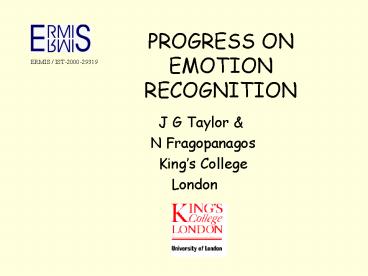PROGRESS ON EMOTION RECOGNITION - PowerPoint PPT Presentation
1 / 17
Title:
PROGRESS ON EMOTION RECOGNITION
Description:
Similar top ranking features for 3 out of 4 FeelTracers (but still differences) Different top ranking features for different SALAS subjects - Is there a male ... – PowerPoint PPT presentation
Number of Views:84
Avg rating:3.0/5.0
Title: PROGRESS ON EMOTION RECOGNITION
1
PROGRESS ON EMOTION RECOGNITION
- J G Taylor
- N Fragopanagos
- Kings College
- London
2
KCL WORK IN ERMIS
- Analysis of emotion v cognition in human brain
(?simulations of emotion/attention paradigms) - ? emotion recognition architecture ANNA
- ANNA hidden layer emotion state, feedback
control for attention ( IMC) - Learning laws for ANNA developed
- ANNA fuses all modalities or only one
- HUMAINE WP3 WP4
3
BASIC BRAIN EMOTION CIRCUIT
- Valence in amygdala OBFC
- Attention in parietal PFC
- Interaction in ACG
4
- SIMPLIFIED ARCHITECTURE OF EMOTIONAL/COGNITIVE
PROCESSING IN THE BRAIN -
5
DETAILED ARCHITECTURE FOR FACES CLASSIFICATION
gender
6
BASIC ERMIS EMOTION RECOGNITION ARCHITECTURE
Feature vector Inputs
Attention control system
Output as recognised emotional state
?
?
Emotion state as hidden layer
7
ANNAAssume linear outputHidden layer
responseIMC node responseThen solve
self-consistent equations for (y, z) for each
training input by relaxation
8
NATURE OF ANNA
- Handles both unimodal and multi-modal data (input
vector x of arbitrary dimension, not too large) - Needs consistent input and output data x(t),
OUT(t), with t specified for both x
OUT(activat, evaluat) - Uses SALAS date-base (450 tunes)
- from QUB (Roddie/Ellie/Cate)
9
UNIMODAL RESULTS
- Can use numerous representations of emotion
extreme, continuous in n dimensions, - ANNA ? FEELTRACE output (continuous 2-D)
- Trained on unimodal for prosody
- First look at word content
10
Text Post-Processing Module
- Prof. Whissell compiled
- Dictionary of Affect in Language (DAL)
- Mapping of 9000 words ? (activation-evaluation),
based on students assessment - Take words from meaningful segments obtained by
pause detection ? (activation-evaluation) space - But humans use context to assign emotional
content to words
11
Text Post-Processing Module (SALAS data)
- Table 1. Quadrant match for normal text (full
DAL). - Participant P1 P2 P3 P4 P9 P12 All
- Quadrant match () 21.4 12.5 21.4 30.4 25.0 19.6 1
6.1 - Table 2. Quadrant match for scrambled text (full
DAL). - Participant P5 P6 P7 P8 P10 P11 All
- Quadrant match () 07.1 23.2 25.0 32.1 23.2 21.4 2
1.4 - Table 3. Standard deviation of participants
assessments for normal and scrambled text
(average over all passages assessed). - Normal Scrambled
- Evaluation 1.24 1.45
- Activation 1.55 1.73
- Table 4. Quadrant match averaged over
participants groups for normal text and
scrambled text when threshold for DAL range is
varied. - Threshold 0.0 0.25 0.5 0.75
- Normal text 16.1 16.0 12.5 16.4
- Scrambled text 21.4 21.4 19.6 21.8
- The higher the threshold the higher emotionally
rated words are spotted only.
Conclude need further context/semantics
12
Correlational analysis of ASSESS features
- Correlational analysis between 450 ASSESS
features and FeelTrace gt - ASSESS features correlate more highly with
activation - Similar top ranking features for 3 out of 4
FeelTracers (but still differences) - Different top ranking features for different
SALAS subjects - -gtIs there a male/female trend? Difficult to say
- insufficient data
13
ANNA on top correlated ASSESS features
- Quadrant match using top 10 activation features
top 10 evaluation features and activation
evaluation output space
14
ANNA on top correlated ASSESS features
- Half-plane match using top 10 activation features
and activation only output space
15
PRESENT SITUATION OF ANNA MULTIMODAL
- Time-stamped data now becoming available for
lexical (ILSP) face streams (NTUA) - Expect to have results in about 1 month for
recognition for fused modalities
(faces/prosody/words)
16
CONCLUSIONS
- UNIMODAL ANNA on prosody OK (especially
activation) - MULTIMODAL Soon to be done
- On semi-realistic data (SALAS QUB)
- Future work
- 1) analysis of detailed results
- 2) insert temporality in ANNA
17
QUESTIONS
- How to handle variations across experiencers and
across FEELTRACERS? - How to incorporate expert knowledge?
- How combine recognition across models?
- Coding of emotions as dimensional reps or as
dissociated states (sad AMYG v angry OBFC)? - Nature of emotions as goal/reward assessment
(frustration ? anger impossible ?sadness, etc
brain-based)?

